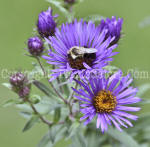 O.k.
There are professionals in the botanical (and
zoological) world
called
taxonomists. Their job is to study plants
with
regard to the proper classification of each type into families,
genera, species and sub-groups. They do this based
on the best available information at a particular
point in time. That's all they can do after all.
O.k.
There are professionals in the botanical (and
zoological) world
called
taxonomists. Their job is to study plants
with
regard to the proper classification of each type into families,
genera, species and sub-groups. They do this based
on the best available information at a particular
point in time. That's all they can do after all.
So, whenever our
knowledge base increases or we discover new techniques
such as DNA testing, taxonomists may determine
that a classification they made in the past is no
longer valid. This happened to our understanding of
the genus, Aster,
starting with a study made in 1994. It prompted the
reclassification of certain Aster species into
other, new or existing, genera.
Basically, there were
two broad categories of plants lumped into the
genus, Aster. One of these originated in the
area of the world called
Eurasia. The other populations consisted of about
180 species that are native to
North America.
When the original
classification was made long ago, it was felt that
these two groups of plants were the same so they
were lumped together in one genus, Aster. Now,
through DNA and other studies, it has been
determined that the two groups are, in fact,
different and therefore, should be in separate
genera.
The taxonomists came
up with the recommendation that the species that are
of Eurasian origin should keep the Aster
designation. Those from North America have been
renamed into several other genera.
About 90 of the 180
North American species have been moved into the
genus,
Symphyotrichum. The others have been
distributed to other genera including
Almutaster,
Ampelaster, Aster,
Canadanthus,
Chloracantha,
Doellingeria,
Eucephalus,
Eurybia,
Oclemena,
Oreostemma, and
Sericocarpus.
To add to the
confusion, two American species remain in the genus,
Aster. These are
Aster alpinus which is native from Northeastern
Asia into
Alaska and down through the Rocky Mountains. The other is
Aster tataricus which, although it is native
to Northeastern
Asia, has become naturalized in
areas east of the Mississippi River.
What does all this
mean to the average backyard gardener? Probably not
a lot, at least in the short run. It will be some
time before nurseries begin to catch up with the
changes. At first, they will begin to label common
landscape asters with both the old and the new
names. It usually takes a very long time before the
transition of names on the types that are very
common will be completed.



